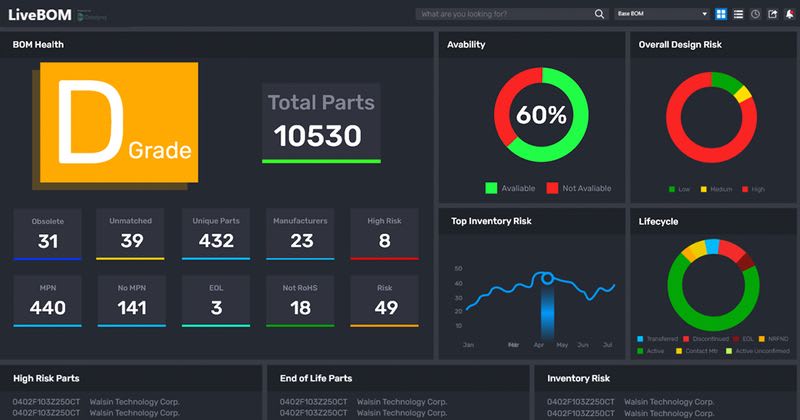Electronic Parts Database Software for Improved Component Management
Key Takeaways
-
Electronic parts database software consolidates data from global manufacturers in one location, enhancing the efficiency of part selection
-
Software aids in tracking compliance with environmental and safety standards such as RoHS and REACH, while also providing tools to assess component risks like end-of-life (EOL) status
-
Seamless integration with ECAD systems is crucial for maintaining consistent design data across workflows.

Live BOM has a useful overall BoM health dashboard.
In the lifecycle of electronics design, managing the variety of components involved in building devices can be a critical bottleneck. This is where electronic parts database software becomes an important addition to the designer's arsenal. It streamlines the part selection process by offering a toolkit for component management, selection, supply chain management, and other required features for smooth product assembly, manufacturing, and deployment.
Electronic parts database software simplifies sourcing components by providing centralized parts information from specific manufacturers. By using these databases, engineers can monitor the status of components necessary to develop electronic components, ensuring a smooth electronic design process.
Electronic Parts Database Software: Typical Features
|
Feature |
Description |
|
Comprehensive Parts Data |
Should contain data on all required parts from global manufacturers, regularly updated to ensure accuracy and relevance. |
|
Search and Filter Tools |
Offers advanced search capabilities that allow users to filter parts by performance characteristics, dimensions, and manufacturer, making it easy to find the perfect component. |
|
Real-Time Availability and Pricing |
Integrates with suppliers' systems to provide real-time data on pricing and stock availability, crucial for efficient procurement and inventory management. |
|
Compliance Tracking |
Helps ensure parts comply with environmental and safety standards, such as RoHS, REACH, and more, focusing on compliance tracking. |
Challenges of Traditional Electronic Parts Database
Selecting the wrong component can be costly, and not just in terms of the unit price. It could affect the product's delivery schedule and, potentially, its performance in the market. Dealing with any of the challenges below could lead to selecting the wrong component and slowing down time-to-market.
- Some electronic parts databases may require a manual process for contacting suppliers for part details, which can be slow and error-prone.
- Manually tracking compliance with standards like RoHS and REACH can be labor-intensive and prone to oversights, making regulatory adherence challenging.
- Reliance on emails and meetings for project communication dependent on the database may result in inconsistencies between design and production.
- Incorporating new database software into existing enterprise systems can often present technical and organizational challenges, increasing friction in product lifecycle development.
Unless addressed, another major challenge is the database interacting smoothly with Electronic Computer-Aided Design (ECAD) systems to ensure components and data are reflected across workflows. This integration is critical for maintaining the design data and automating aspects of the design process.

Browsing a part and adding it to the BoM. Part properties are shown on the right.
Cadence Live BOM: A Quality Electronic Parts Database Software
Live BOM is a newly integrated tool with OrCAD X that grants users access to Datalynq’s premier market intelligence platform. Users of OrCAD X can now utilize historical market data on more than 1.6 billion parts, which is collected from Sourceability’s foremost marketplace for electronic components, Sourcengine. This marketplace automatically ensures the quality of the bill of materials, accounting for all components, manufacturers’ part numbers, manufacturers, lifecycle status, and so on.
Live BOM Accessibility in OrCAD X and Online
Users can initiate designs in a web-based view of Live BOM, add parts directly, and later incorporate them into schematics. Changes made to the Live BOM on the web dashboard instantly update Live BOM across all applications, facilitating easy BOM access for team members across disciplines.
Live BOM Availability Score
Using a multi-source availability score, Live BOM ranks parts based on market availability, inventory, lead time, design risk, and vendor options. It highlights high-risk components, such as those that are sole-sourced, discontinued, not recommended for new designs (NRND), or obsolete, allowing engineers to swiftly replace them with readily available alternates, drop-in replacements (DIRs), or functionally equivalent components.
Live BOM solves the traditional challenges discussed above through its key features.
Live BOM Key Features
|
Feature |
Description |
|
Real-Time Data Integration |
Integrates real-time data from the cloud, ensuring that the BOM is always up-to-date with the latest information. |
|
Component Risk and Availability |
Displays risk scores and RoHS compliance, including high-risk and EOL status, and shows availability from various suppliers. |
|
Detailed Component Analysis |
Enables detailed viewing of components in list format, with supply chain details fetched from Sourcengine. |
|
Alternates and Compatibility |
Offers alternate MPN suggestions with compatibility checks and allows users to view and select alternates directly. |
|
Optimization and Updating |
Allows users to update and optimize the BOM directly within the tool, improving overall BOM health. |
Experience seamless integration of your electronic parts database software with Live BOM, included with OrCAD X.
Leading electronics providers rely on Cadence products to optimize power, space, and energy needs for a wide variety of market applications. To learn more about our innovative solutions, talk to our team of experts or subscribe to our YouTube channel.